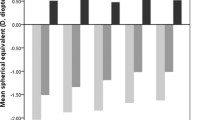Abstract
Background
Age-related blepharoptosis, or ptosis, affects vision and appearance. Associations with age, gender, BMI, and diabetes have been explored, but the link to blood lipids remains unclear. The impact on refraction also lacks consensus. This study addresses gaps by investigating ptosis prevalence and factors in a representative Chinese population, aiming for a comprehensive understanding.
Methods
A cross-sectional study was conducted among individuals aged 50 and above who were willing to participate in comprehensive systemic check-ups, behavioral questionnaires, and ophthalmic examinations at Yaoxi Community Health Center in Wenzhou City, Zhejiang Province.
Results
The prevalence of blepharoptosis among the elderly participants at this health center was 27.16%. Individuals with blepharoptosis tended to be older, male, exhibited slightly higher body mass index, wider waist circumference, engaged in lower exercise frequency, and had a higher prevalence of hypertension, diabetes, and with-the-rule astigmatism compared to their counterparts without these conditions. Adjusting for all other confounding variables, older age, being male, higher fasting plasma glucose (FPG), and lower exercise frequency displayed statistically significant relationships with blepharoptosis. After examining the distribution of blepharoptosis degrees within relevant factor subgroups, we noted a higher prevalence of severe ptosis in subgroups associated with older age, male gender, higher FPG, and against-the-rule astigmatism.
Conclusion
The notable associations with age, gender, FPG, and exercise level suggest a multifactorial etiology for blepharoptosis. The observed link between with-the-rule astigmatism and blepharoptosis implies a potential contributory role in the refractive aspect of blepharoptosis.
Level of Evidence IV
This journal requires that authors assign a level of evidence to each article. For a full description of these Evidence-Based Medicine ratings, please refer to the Table of Contents or the online Instructions to Authors www.springer.com/00266.



Similar content being viewed by others
References
Small RG, Sabates NR, Burrows D (1989) The measurement and definition of ptosis. Ophthalmic Plast Reconstr Surg 5(3):171–175
Bacharach J, Lee WW, Harrison AR, Freddo TF (2021) A review of acquired blepharoptosis: prevalence, diagnosis, and current treatment options. Eye (Lond) 35(9):2468–2481
McKean-Cowdin R, Varma R, Wu J, Hays RD, Azen SP (2007) Severity of visual field loss and health-related quality of life. Am J Ophthalmol 143(6):1013–1023
Richards HS, Jenkinson E, Rumsey N, White P, Garrott H, Herbert H, Kalapesi F, Harrad RA (2014) The psychological well-being and appearance concerns of patients presenting with ptosis. Eye (Lond) 28(3):296–302
Paik JS, Han K, Yang SW, Park Y, Na K, Cho W, Jung SK, Kim S (2020) Blepharoptosis among Korean adults: age-related prevalence and threshold age for evaluation. BMC Ophthalmol 20(1):99
Kim MH, Cho J, Zhao D, Woo KI, Kim YD, Kim S, Yang SW (2017) Prevalence and associated factors of blepharoptosis in Korean adult population: the Korea national health and nutrition examination survey 2008–2011. Eye (Lond) 31(6):940–946
Hashemi H, Khabazkhoob M, Emamian MH, Yekta A, Jafari A, Nabovati P, Fotouhi A (2016) The prevalence of ptosis in an Iranian adult population. J Curr Ophthalmol 28(3):142–145
Sridharan GV, Tallis RC, Leatherbarrow B, Forman WM (1995) A community survey of ptosis of the eyelid and pupil size of elderly people. Age Ageing 24(1):21–24
Shirado M (2012) Dyslipidaemia and age-related involutional blepharoptosis. J Plast Reconstr Aesthet Surg 65(6):e146-150
Wilson G, Bell C, Chotai S (1982) The effect of lifting the lids on corneal astigmatism. Am J Optom Physiol Opt 59(8):670–674
Vihlen FS, Wilson G (1983) The relation between eyelid tension, corneal toricity, and age. Invest Ophthalmol Vis Sci 24(10):1367–1373
Pesudovs K (2005) Wavefront aberration outcomes of LASIK for high myopia and high hyperopia. J Refract Surg 21(5):S508-512
Wouters RJ, van den Bosch WA, Mulder PG, Lemij HG (2001) Upper eyelid motility in blepharoptosis and in the aging eyelid. Invest Ophthalmol Vis Sci 42(3):620–625
Guyuron B, Harvey D (2016) Periorbital and orbital aging: senile enophthalmos as a cause of upper eyelid ptosis. Plast Reconstr Surg 138(1):31e–37e
Bastiaensen LA (1985) Cause of acute blepharoptosis in diabetes mellitus is mostly an oculomotor nerve palsy. Ophthalmology 92(9):63a–64a
Bosco D, Costa R, Plastino M, Branca D, Cotronei P, Sperlì T, Santacroce N, Siniscalchi A, Consoli D, Ceccotti C, Mungari P, Fava A (2009) Glucose metabolism in the idiopathic blepharoptosis: utility of the oral glucose tolerance test (OGTT) and of the insulin resistance index. J Neurol Sci 284(1–2):24–28
Phillips SM (2009) Physiologic and molecular bases of muscle hypertrophy and atrophy: impact of resistance exercise on human skeletal muscle (protein and exercise dose effects). Appl Physiol Nutr Metab 34(3):403–410
Ross M, Kargl CK, Ferguson R, Gavin TP, Hellsten Y (2023) Exercise-induced skeletal muscle angiogenesis: impact of age, sex, angiocrines and cellular mediators. Eur J Appl Physiol 123(7):1415–1432
Acknowledgements
The authors would like to express their gratitude to all the participants who contributed to this manuscript.
Funding
This work was supported by the National Key Research and Development Program of China (2020YFC2008200).
Author information
Authors and Affiliations
Corresponding authors
Ethics declarations
Conflicts of interest
The authors declare that they have no conflict of interest.
Ethical Standards
All procedures performed were in accordance with the ethical standards of the institutional and national research committee and with the 1964 Helsinki declaration and its later amendments or comparable ethical standards. Ethical approval has been obtained by the Institutional Review Board at Wenzhou Medical University. Reference number 2022-032-K-24-01. Informed consent was obtained from all individual participants included in the study.
Additional information
Publisher's Note
Springer Nature remains neutral with regard to jurisdictional claims in published maps and institutional affiliations.
Rights and permissions
Springer Nature or its licensor (e.g. a society or other partner) holds exclusive rights to this article under a publishing agreement with the author(s) or other rightsholder(s); author self-archiving of the accepted manuscript version of this article is solely governed by the terms of such publishing agreement and applicable law.
About this article
Cite this article
Hu, S., Chen, X., Zheng, G. et al. The Prevalence and Risk Factors of Blepharoptosis in an Elderly Asian Population. Aesth Plast Surg 48, 1298–1305 (2024). https://doi.org/10.1007/s00266-023-03804-2
Received:
Accepted:
Published:
Issue Date:
DOI: https://doi.org/10.1007/s00266-023-03804-2




